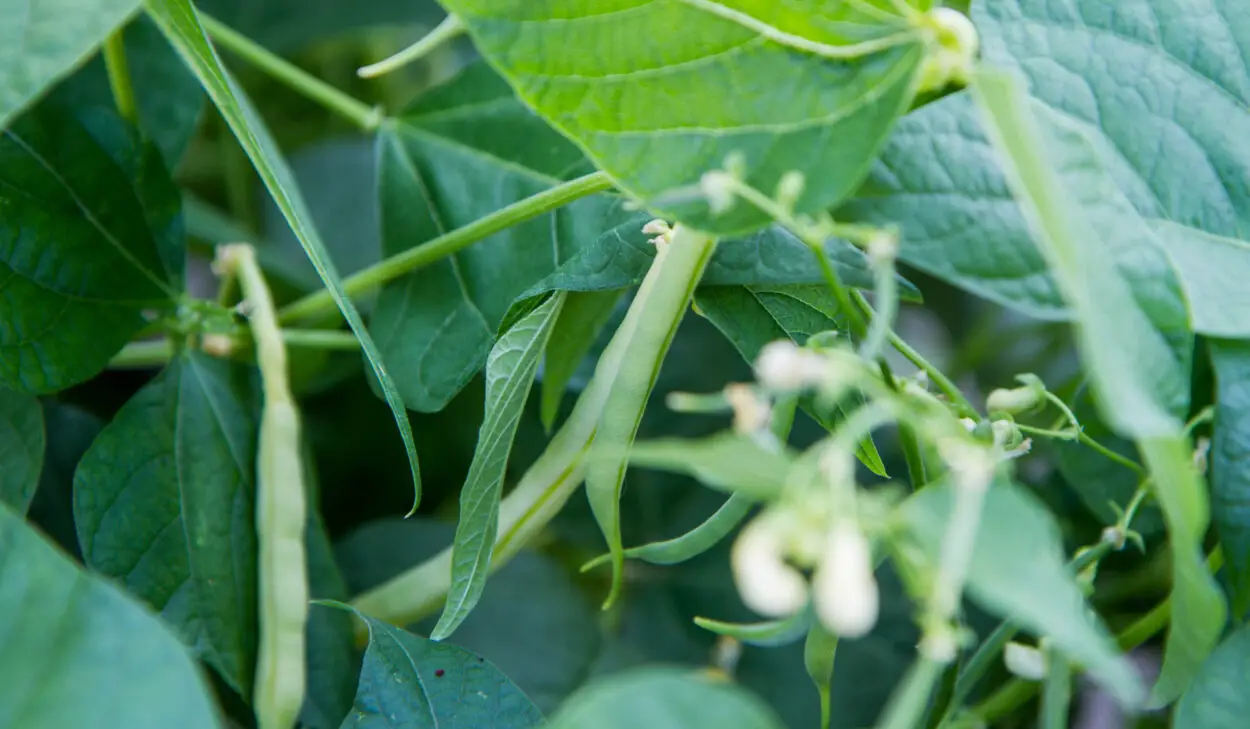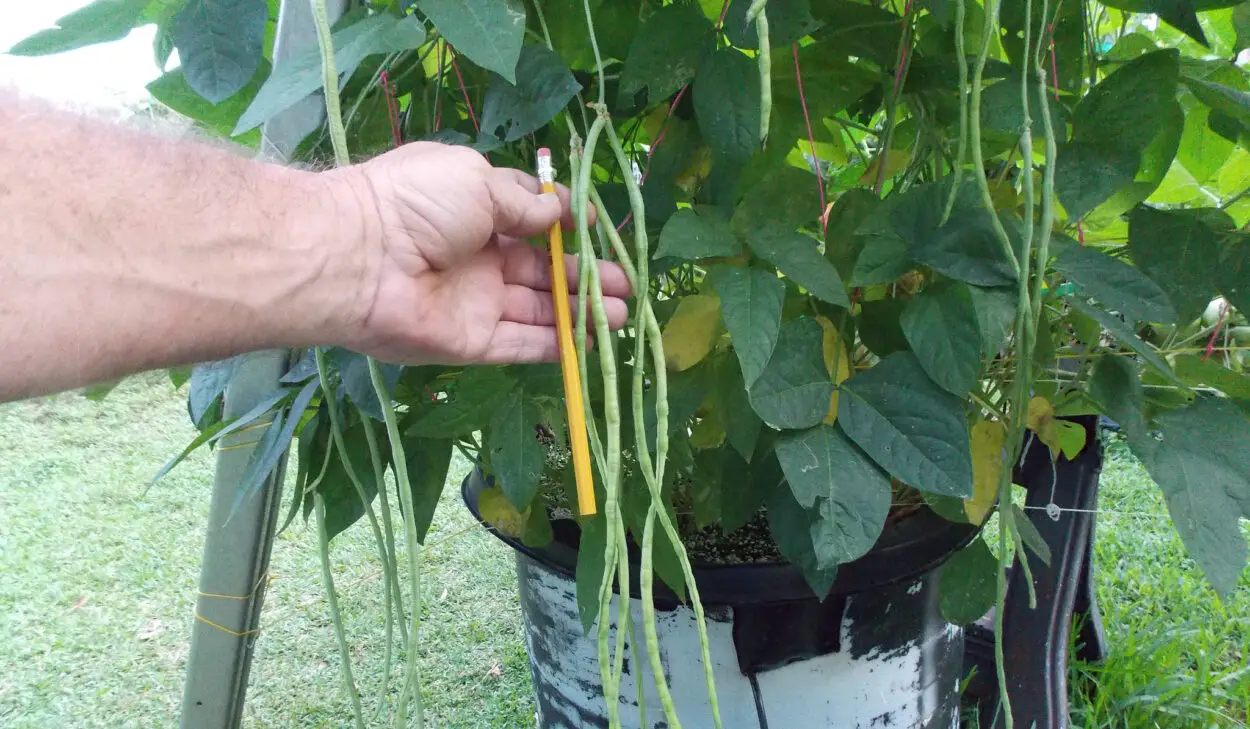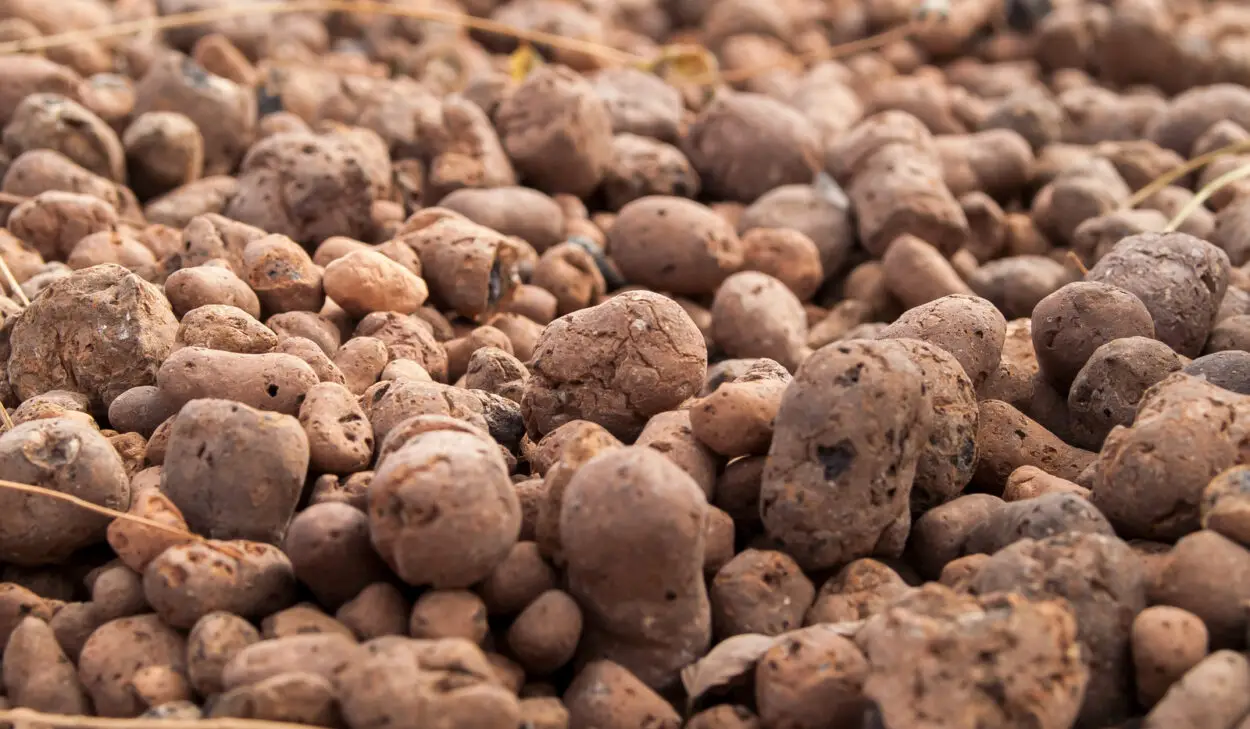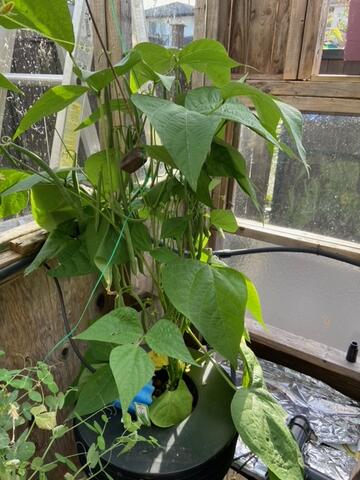The Secret To Growing Hydroponic Beans: A Complete Guide To Growing the Best Beans Indoors

This post follows our research editorial guidelines.

If you’re looking to embrace your inner gardener but are short on space, you can consider growing hydroponic beans indoors. It’s a smart, innovative way to cultivate fresh, nutritious beans right in your own home without using any soil or space.
Given that you’ve landed on this page, chances are, you are not new to indoor growing but instead are looking to push the limits of what your DWC system can handle.

Get ready to roll up your sleeves, dive into the world of hydroponic beans and avoid the pitfalls that soil-based seeds won’t need to worry about.
Table of Contents
Can You Grow Hydroponic Beans?
Yes, you can definitely grow beans hydroponically. This particular method allows you to grow a variety of plants, including beans, in a soilless medium, usually using nutrient-rich water. This system simulates the natural conditions beans need to thrive but offers us more control over the growth conditions.
“By growing hydroponically, you can expect faster growth rates, more yield, and the opportunity to grow in places where soil is not available. It’s a game-changer for food production in urban environments.”
not available. It’s a game-changer for food production in urban environments.” — Dr. Howard Resh, renowned hydroponics researcher.
This is primarily because the beans receive nutrients directly, without competition from soil-based organisms, and the controlled environment reduces the risk of pests and diseases.
And the best part? You can do all of this within your living room or kitchen.
How Long Does It Take To Grow Beans Hydroponically?
It takes nearly 60 to 80 days to grow beans hydroponically. Let’s break down the timeline into stages to understand the process better:
- Germination (5-8 days): This is when your bean seeds sprout. You’ll typically see the first shoots popping out within a week. To accelerate germination, you can soak the seeds in water for about 12 hours before planting them.
- Seedling Stage (10-14 days): The sprouts will grow into small seedlings, developing roots and leaves. These are the plant’s foundational elements, and maintaining ideal conditions here is crucial.
- Vegetative Stage (15-30 days): In this stage, the plants focus on photosynthesis to support rapid growth. You’ll see lots of greenery as your beans develop a strong stems and leaves.
- Flowering Stage (10-14 days): Next, your bean plants will start to flower. These flowers will eventually turn into the beans we harvest. During this stage, plants often need additional nutrients, particularly phosphorus.
- Fruiting and Harvest (20-40 days): After flowering, the plants start producing bean pods. The beans are typically ready to harvest once the pods are firm and have reached their full color.

Best Bean Varieties For Hydroponics
Hydroponic farming allows for the cultivation of various bean types, each offering unique benefits and requiring specific growth conditions. Here are a few:
Pole Beans
Pole Beans, also known as climbing beans, are an excellent choice for hydroponic systems. The two types that are most suitable for this method are:
Type 1: Blue Lake Pole Beans
Known for their vibrant green pods, Blue Lake pole beans are a favorite for hydroponic cultivation. These beans are crisp, tender, and known for their excellent flavor. A popular choice among growers and consumers, these beans thrive in well-lit conditions and need sturdy support due to their vining growth habit so be sure to have a trellis ready for them to climb on.
Type 2: Kentucky Wonder Pole Beans
These are among the oldest and most well-regarded bean varieties grown in the United States. They yield heavily, producing thick, fleshy pods with a distinctly sweet flavor.
As with Blue Lake, Kentucky Wonder pole beans need a good deal of light and will need support structures in hydroponic setups. They benefit from higher levels of potassium, which promote strong stem growth and increased yield.
Bush Beans
Bush Beans are compact plants making them an ideal bean variety for hydroponics. Bush beans require less vertical space and often mature earlier than pole varieties. For hydroponics, the following types are highly recommended:
Type 1: Provider Bush Beans
Known for their excellent disease resistance and reliable yields, provider bush beans are a good choice for hydroponic systems. They produce an abundance of round, stringless pods that are rich in flavor. These plants can adapt to a variety of conditions, which makes them ideal for indoor hydroponics.
Type 2: Contender Bush Beans
This variety is another excellent choice for hydroponics. Contenders are early producers, typically ready for harvest in just 50 days. They offer good disease resistance and produce a substantial yield of stringless, tender pods.

How to Grow Hydroponic Beans
Here is a step-by-step guide on how to grow hydroponic beans:
Step 1: Germination
Your journey starts here. Opt for high-quality bean seeds from a trusted supplier to ensure a successful germination rate. To sprout your beans, place them between damp paper towels, cover them with a plastic bag, and store in a warm area.
The perfect temperature for bean germination ranges between 70-80°F (21-27°C). In around 5-7 days, you should see the radicle (embryonic root) emerging.
Step 2: Light
Next up is light, a crucial ingredient for your beans’ growth. Once your seeds sprout, beans need approximately 12-16 hours of light each day. Personally, I keep my hydroponic lights on for 20 hours during the vegetative stage for plants and reduce them down to the 12-16 hour range once the flower and fruit stage begins.
You can either use natural sunlight if your setup is in a greenhouse, or artificial grow lights if indoors. For artificial lighting, LED full-spectrum lights are an excellent choice. They deliver the necessary light spectrum for plant growth, and are energy-efficient to boot!

Step 3: Growing Medium
The growth medium plays a significant role in hydroponic farming. For hydroponic beans, the optimal mediums are perlite or expanded clay pebbles. Since bean seeds are larger than many other vegetables smaller growing medium vermiculite will also work well.
Perlite has a neutral pH, preventing any alteration in the alkalinity or acidity of your nutrient solution. Expanded clay pebbles strike a balance of moisture, food, and air for your plants, preventing root rot by allowing critical oxygen to reach plant roots.
Step 4: Water
The watering needs of hydroponic beans farming are remarkably less than traditional soil-based farming. This is due to the fact that the water has less exposure to light and air and thus less evaporation occurs. The amount of water you need will depend on your hydroponic setup. For example, my hydroponic garden kit has a 10 gallon water basin that I only need to top up once a month. The circulation of the water ensures that the water stays fresh and free of pathogens.
The water should contain a nutrient mix, providing vital nutrients to the plants, and replicating the nutrient-rich nature of the soil.
A successful hydroponic setup requires careful management of water quality and nutrient levels. Regular testing of the nutrient solution is necessary to maintain optimal pH and nutrient concentration.
The ideal nutrient pH for beans is between 6.0 and 6.5. The EC level should range from 2.0-4.0, and the PPM should be between 1400-2800.
Step 5: Nutrients
For beans, the essential nutrients are Nitrogen (N), Phosphorus (P), and Potassium (K). Besides these macronutrients, beans also require secondary nutrients like Calcium and Magnesium, and trace elements such as Iron, Manganese, Zinc, Copper, Molybdenum, and Boron. Normally in soil-bound conditions, beans make use of beneficial fungi like the rhizobium in order to fix nitrogen for use in the soil. Since hydroponics lacks this feature you can expect to use a healthy dose of a balanced liquid fertilizer.
Depending on the specific variety, you might need to adjust the proportions, but generally, beans need higher Nitrogen levels for lush foliage growth, then a healthy bump of phosphorous when the fruiting stage begins.
Step 6: Spacing
Overcrowding can lead to competition for nutrients and can also encourage disease spread. For bush beans, space plants about 4-6 inches apart, while pole beans should be about 6-8 inches apart. This will ensure each plant has room to grow and access to enough light.

Step 7: Support
The trellis or stakes should be installed at planting time to avoid disturbing the root system later. As the beans grow, gently guide the vines onto the support. Some beans will naturally twine around the support, but others may need to be gently tied with soft twine or garden ties.
An added advantage of providing support is the efficient use of space, particularly in indoor hydroponic setups.
Step 8: Preventing Pests
Pests can pose significant challenges to hydroponic bean farming. Some common pests affecting beans include aphids, spider mites, and thrips.
Aphids, tiny sap-sucking insects, can lead to yellowing leaves and stunted growth. Spider mites, also sap feeders, can cause bean leaves to develop yellow speckles and eventually drop.
Regularly inspect your plants for any signs of pests and intervene early to prevent outbreaks.
Physical controls such as handpicking, using water sprays to dislodge pests, or using yellow sticky traps to monitor and catch flying pests can be effective.
Biological controls such as introducing beneficial insects like ladybugs or lacewings that prey on these pests are also beneficial.
Step 9: Disease Prevention
Fungal diseases such as powdery mildew and root rot can be quite problematic. Powdery mildew presents as white, powdery spots on leaves, stems, and pods, while root rot, caused by waterlogged conditions, can lead to wilting and yellowing of the plant.
To manage these diseases, maintain optimal environmental conditions. A well-ventilated growing area can help prevent the build-up of humidity, which often favors fungal growth. Regularly clean and disinfect your hydroponic system to prevent the buildup of disease-causing organisms.
Types of Hydroponics to Grow Beans In
There are several types of hydroponic systems suitable for growing beans, each with its unique features and benefits.
Nutrient Film Technique (NFT)
NFT is a hydroponic technique where a thin film of nutrient solution is continuously circulated over the roots of the plants, which are usually supported by a sloped trough or tube.
The technique ensures that the plant roots have access to water, oxygen, and nutrients simultaneously. NFT systems are popular for their simplicity and efficiency. However, they may not be the best choice for larger bean plants due to the plants’ size and root structure.
Deep Water Culture (DWC)
Deep water culture is a hydroponic method that involves suspending plant roots in a nutrient-rich, oxygenated water solution. An air stone or diffuser provides oxygen to the roots, promoting vigorous growth.
DWC is an excellent choice for growing beans due to its simplicity and the fact that it can support larger plants. On the downside, DWC systems can consume a lot of water and electricity, and temperature management can be challenging.
Ebb and Flow
Ebb and Flow, also known as flood and drain, is a hydroponic system where plants are grown in trays or pots filled with an inert medium such as rock wool or perlite. The tray or pot is periodically flooded with nutrient solution and then drained back into the reservoir.
FAQs
Is it Better to Grow Beans in Water or Soil?
The decision to grow beans in water (hydroponics) or soil depends on your specific situation and preference. Both methods have advantages. Soil-grown beans can be more forgiving for beginners, requiring less precise control of nutrients and water. However, hydroponically grown beans often have better yield, grow quicker than in soil, and can be controlled with precision.
Can I Grow Beans in My AeroGarden?
Yes, you can grow beans in your AeroGarden. It’s a Deep Water Culture system that is particularly well-suited for beans due to its efficient nutrient delivery and the high oxygen levels it provides.
However, make sure to provide ample space for the beans to grow, as they can become quite large compared to other plants typically grown in an AeroGarden. A small countertop Aerogarden will only be able to handle 1 or 2 plants at the most. If you need more space for your beans try growing them in the AeroGarden Farm instead.
Final Thoughts
Hydroponic bean growing is not just fun, but it’s also a clever way to make the most of your indoor space. You don’t need to be an expert gardener. All you need are quality seeds, a cozy spot for your setup, and a dash of dedication.
Before you know it, you’ll be harvesting your home-grown beans, fresher and healthier than ever. So why wait?
Start your hydroponic journey today!

Before you go!
The Secret to Growing The Best Hydroponic Broccoli
Hydroponic Drip System Explained: The complete guide
Hydroponic Deep Water Culture? Get Growing in 10 Easy Steps
Hydroponics vs. Aeroponics: Which one Reigns Supreme?